Abstract
A proper total k-coloring of G with for each is called a total neighbor sum distinguishing k-coloring, where . Pilśniak and Woźniak conjectured that every graph with maximum degree exists a total neighbor sum distinguishing -coloring. In this paper, we proved that any IC-planar graph with satisfies this conjecture, which improves the result of Song and Xu.
1. Introduction
Let be a simple graph. Set and . A total neighbor sum distinguishing k-coloring (for short, tnsd) is a mapping satisfying the following conditions:
- (i)
- for any two adjacent or incident elements in ;
- (ii)
- for each .
The total neighbor sum distinguishing index of G, denoted by , is the smallest integer k such that G has a tnsd k-coloring.
In 2015, Pilśniak and Woźniak [1] first studied the coloring and gave the conjecture about the tnsd index as follows:
Conjecture 1
([1]). For every graph G, .
Up to now, many special classes of graphs had been proved to satisfy Conjecture 1, including complete graphs, bipartite graphs, subcubic graphs [1], 2-degenerate graphs with maximum degree [2], -minor-free graphs [3], planar graphs with maximum degree [4], and planar graphs with maximum degree but without triangles [5].
A graph is 1-planar if it can be embedded on the plane so that each edge is crossed at most once. In 1965, Ringel introduced the notion of 1-planar graphs to color a planar graph and its dual simultaneously. In particularly, a 1-planar graph such that each vertex is incident with, at most, a crossing is called an IC-planar (independent crossing planar) graph, which was introduced by Albertson [6] while considering the relationship between the crossing number and the chromatic number.
Recently, the tnsd index on IC-planar graphs has been extensively studied. There are some recent results in the following.
Theorem 2.
Each of the following classes of graphs satisfies Conjecture 1.
- (1)
- IC-planar graph with but without triangles ([7]).
- (2)
- IC-planar graph with but without 2-vertex incident with crossed edge ([8]).
- (3)
- IC-planar graph with ([9]).
There is also a result of list version about the tnsd index of IC-planar graphs, see [10].
In this paper, we discuss any IC-planar graph with maximum degree and obtain the following result, which extends the result of (3) in Theorem 2.
Theorem 3.
Let G be an IC-planar graph. Then, .
2. Preliminaries
Let G be a simple graph and be an edge of G. For a vertex , we use and to denote the degree and neighbors of u in G, respectively. If (resp., , ), we call u an ℓ-vertex (resp., -vertex, -vertex) and an ℓ-neighbor (resp., -neighbor, -neighbor) of v. We use (resp., , ) to represent the number of ℓ-vertices (resp., -vertices, -vertices) adjacent to u in G. For two subsets A and B of , we denote by the set of edges with one end in A and the other in B. In particular, for , we write for .
Theorem 4
([11]). Assume that is an arbitrary field and with degree , where is an integer. If the coefficient of the monomial in P is nonzero, and if are subsets of with , there are such that .
The planar graph obtained from a 1-planar graph G by turning all crossings of G into new 4-vertices on the plane is called the associated planar graph of G. Let . Then, u is called a false vertex and a false neighbor of v if , and a real vertex and a real neighbor of v otherwise. We use to denote the set of faces in . For each face , we call f a false face if it is incident with one false vertex, and a real face otherwise. A face with degree ℓ is called an ℓ-face. Unless stated otherwise, an ℓ-face means a real or false ℓ-face throughout each section in the following.
Lemma 1
([12]). Assume that G is a 1-planar graph and is its associated planar graph. If a real 3-vertex u is adjacent to a false vertex v in , then is not incident with two 3-faces in .
3. Proof of Theorem 3
Let (, , respectively) represent the set of vertices in G of degree i (at most i, at least i, respectively). For the graph G, a graph is smaller than it if one of the below conditions is satisfied.
- (i)
- ;
- (ii)
- In the lexicographic order, precedes , where .
We say a graph is minimal for some property if no smaller graph admits the property. To obtain a smaller graph, , than G, we will frequently delete some edges or split some vertices of G in the following.
From now on, let G be a minimal graph not satisfying Theorem 3 and . Then, any graph that is smaller than G has a tnsd k-coloring . By splitting a vertex v into two vertices and , we obtain a smaller graph than G, then has a tnsd k-coloring . If we can obtain a tnsd k-coloring of G from the by sticking and into v, we say that and can be properly stunk. In the following, we will often extend a tnsd k-coloring of to a tnsd k-coloring of G to obtain a contradiction. Set . Assume that X is a subset of and is a mapping. For each , set
Assume that u is a -vertex in G and is a mapping satisfying the conditions as follows:
- (i)
- for any adjacent or incident elements ;
- (ii)
- for any two adjacent vertices .
Since , . Thus, we can extend the to a tnsd k-coloring of G, which is a contradiction. For simplicity, we will omit the colors of all -vertices in the following discussion.
In Figure 1 and Figure 2, a black vertex represents that its neighbors are all depicted and a white vertex means that its neighbors may not be all depicted.
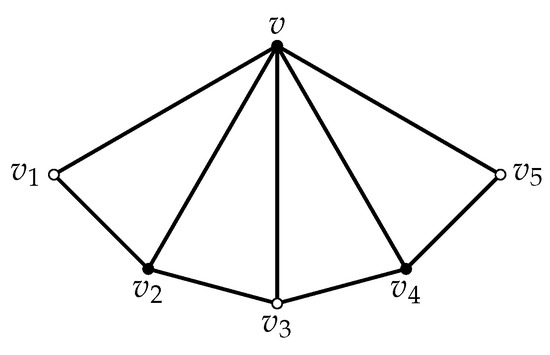
Figure 1.
No configuration in G.
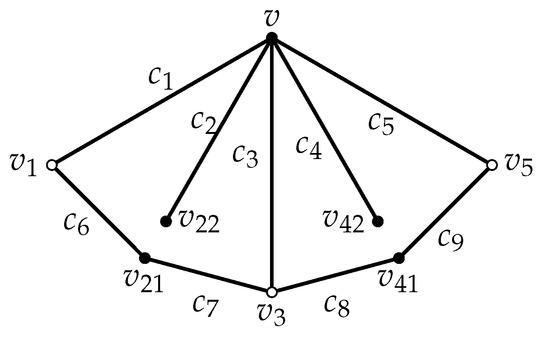
Figure 2.
No configuration with colors in G.
Claim 1.
The graph G contains no configuration in Figure 1.
Proof.
Suppose that G contains the configuration in Figure 1. By splitting the two 3-vertices of the configuration in Figure 1 into and , respectively, we obtain a smaller graph than G. Then, has a tnsd k-coloring . Without loss of generality, set , , , , , , , , and (see Figure 2).
If we can properly stick with , respectively, we can obtain a tnsd k-coloring of G, which is a contradiction. Thus, assume that at least one of and cannot be stuck properly below. Let .
Case 1. Suppose that one of and cannot be stuck properly. If can not be stuck properly, . Without loss of generosity, set .
Set , , and . Then, we assign , , and for every .
Set , , and . Then, we assign , , , , and for every .
Set . If , we assign , , , and for every . If and , we assign , , , , , and for every . If and , we assign , , , , and for every .
Set . If and , we assign , , , and for every . If and , we assign , , , , , , and for every . If , we assign , , , , , and for every .
In each case above, by sticking and into for , we obtain the graph G. Since both and are 3-vertices in G, we can obtain a tnsd k-coloring of G from . By symmetry, if cannot be stuck properly, we can also obtain a tnsd k-coloring of G. It is a contradiction.
Case 2. Assume that both and cannot be stuck properly. Then, and . Let , , , , , , and for every . By sticking and into for , we obtain the graph G. Since both and are 3-vertices in G, we can obtain a tnsd k-coloring of G from , which is a contradiction. □
The below Claim 2 follows from (3) in Theorem 2.
Claim 2.
Claim 3.
If , then
Proof.
By contradiction, suppose that there is a vertex and a vertex such that . Let . Then, has a tnsd k-coloring . We first erase the colors on u and v from . Without loss of generality, set and . Then,
Let be a map on obtained from by assigning , , , and for every . Set
With the help of MATHEMATICA, we have . By Theorem 4, there is a color , a color , and a color such that . Therefore, we can extend the to a tnsd k-coloring of G by recoloring with colors and coloring with color , respectively. It is a contradiction. □
Claim 4.
If , and .
Proof.
We first prove when . By contradiction, suppose that there is a vertex and a vertex such that . Let . Then, has a tnsd k-coloring . We first erase the colors on u and v from . Note that v is a -vertex. Then,
Let be a map on obtained from by assigning , , and for every . Set
By applying MATHEMATICA, we have . By Theorem 4, there is a color and a color such that .
Since v is a -vertex, we can obtain a tnsd k-coloring of G from the by recoloring u with color and coloring with color , respectively. This is a contradiction.
Next, we show when . Suppose, to the contrary, that there is a vertex and two vertices such that . Let . Then, has a tnsd k-coloring . We first erase the colors on u, , and from . Then,
Let be a map on obtained from by assigning , , and for , and for every . Set
With the help of MATHEMATICA, we have . By Theorem 4, there is a color , a color , and a color for such that . Therefore, we can extend the to a tnsd k-coloring of G by recoloring with colors and coloring with color for , respectively. This is a contradiction. □
Claim 5.
If with , then,
- (1)
- (2)
- when
Proof.
Suppose to be contrary that there is a vertex , a vertex , and vertices with such that and for . Let . Then, has a tnsd k-coloring . We first erase the colors on u and with from . Without loss of generality, set with . Note that is a -vertex. Then,
Let be a map on obtained from by assigning
and for every Set
When , , and we have by applying MATHEMATICA. When , , and we have by applying MATHEMATICA. By Theorem 4, there is a color , a color with , and a color with such that when . Since is a -vertex, we can extend the to a tnsd k-coloring of G by recoloring with colors and coloring with colors , respectively. This is a contradiction. □
Claim 6.
If with , then
- (1)
- (2)
- when
- (3)
- when and
Proof.
By contradiction, suppose that there is a vertex , a vertex , a vertex , vertices with such that , , and for . Let . Then, has a tnsd k-coloring . We first erase the colors on u and with from . Without loss of generality, set . Note that is a -vertex and is a -vertex with . Then,
Let be a map on obtained from by assigning
and for every Set
When , , and we have with the help of MATHEMATICA. When , , and we have with the help of MATHEMATICA. By Theorem 4, there is a color , a color , and a color with such that when . Since is a -vertex with , we can obtain a tnsd k-coloring of G from the by recoloring with colors and coloring with colors , respectively. This is a contradiction. □
Claim 7.
If , then
(1)
(2) when ,
(3) when and ,
(4) when , and .
Proof.
Suppose to the contrary that there is a vertex , a vertex , a vertex , a vertex , and three vertices such that , , , and for . Let . Then, has a tnsd k-coloring . We first erase the colors on u and with from . Without loss of generality, set . Note that is a -vertex, is a -vertex, and is a -vertex with . Then,
Let be a map on obtained from by assigning
and for every Set
With the help of MATHEMATICA, we have . By Theorem 4, there is a color , a color , and a color with such that . Since is a -vertex with , we can obtain a tnsd k-coloring of G from the by recoloring with colors and coloring with colors , respectively. This is a contradiction. □
Claim 8.
Let be a 3-cycle in G. Then, .
The following Equation (1) follows from Claims 3∼7.
Let Then, for each .
Claim 9.
If , then,
- (1)
- ,
- (2)
- if ,
- (3)
- if ,
- (4)
- if and ,
- (5)
- if .
Proof.
Note that by the definition of H and Claim 2 for every . By the definition of H, (1), (2), (3), and (4) follow from Equation (1). Below, we prove (5).
(5) Suppose that when . Without loss of generosity, set . Then, by (2). Thus, by Claim 3, and u has at least one -neighbor v in G with by (2). Hence, by (3) and the definition of H, which is a contradiction. Therefore, the statement (5) holds. □
By a similar discussion to that of Claim 9, we can obtain the following Claims 10∼12.
Claim 10.
If , then .
Claim 11.
If with , then,
- (1)
- ,
- (2)
- when .
Claim 12.
If with , then,
- (1)
- ,
- (2)
- when ,
- (3)
- when and .
By Claims 8 and 9, the below claim is immediate.
Claim 13.
Let be a 3-cycle in H. Then,
- (1)
- ,
- (2)
- when .
From now on, we always assume that H has been embedded on the plane such that the number of crossings is as small as possible. Let be the associated planar graph of H and . If is incident with two 3-faces and u is a real ℓ-vertex in , we call u a badℓ-neighbor of v. If is incident with exactly one 3-face and u is a real 3-vertex in , we call u a special 3-neighbor of v. Let denote the number of bad ℓ-neighbors (special 3-neighbors) of v in . Unless stated otherwise, an ℓ-vertex represents a real ℓ-vertex in the following. A 4-face is called a good 4-face if it is incident at most a real -vertex and a bad 4-face otherwise. By Claims 1 and 9, the below Claims 14 and 15 are immediate.
Claim 14.
If , then,
- (1)
- , , and ,
- (2)
- when .
Claim 15.
Every k-face is incident with at most real -vertices in .
Let denote the number of connected components of . Note that each plane graph has exactly one unbounded face. Then, we have
and Euler’s formula
Below, we will apply the discharging method [13] on the planar graph to complete the proof of Theorem 3. Set for any and for any . By Euler’s formula,
and
One can obtain
In order to redistribute charges on and keep the total charges unchanged, we make some discharging rules as follows.
- (R1)
- Let be an edge of .
- (R1.1)
- If u is a bad 3-neighbor of v, u receives 1 from v.
- (R1.2)
- If u is a special 3-neighbor of v, u receives from v.
- (R1.3)
- If u is a bad 4-neighbor of v, u receives from v.
- (R1.4)
- If u is a bad 5-neighbor of v, u receives from v.
- (R2)
- Each real ℓ-vertex with receives 1 from every -face incident with it.
- (R3)
- Let be an edge and u be a false 4-vertex of .
- (R3.1)
- If , u receives 1 when v is not adjacent to any real -vertex and otherwise from v.
- (R3.2)
- If with , u receives 2 when and 1 otherwise from v.
- (R3.3)
- If f is a good 4-face or -face incident with u, u receives 1 from f.
For each , we use to represent the new charge after applying the rules. Then, one can obtain
Thus, there exists a vertex or a face whose charge is negative.
Firstly, it is easy to verify that the new charge of every face is non-negative by Claim 15 and the discharging rules.
Next, we show that the new charge of every real vertex is non-negative. Pick arbitrarily a real vertex v from . Note that v is adjacent to at most a false 4-vertex as G (and thus, H) is an IC-planar graph. Note also that and by the definition of and Claim 9.
For . If v is incident with three -faces, then by (R2). If v is incident with two -faces, it is a common special 3-neighbor of two neighbors, and so by (R1.2) and (R2). If v is incident with one -face, then it is a special 3-neighbor of one neighbor and a common bad 3-neighbor of the other two neighbors, respectively, and so by (R1.1), (R1.2), and (R2). If v is not incident with any -faces, it is a common bad 3-neighbor of three neighbors; so, by (R1.1).
For . If v is incident with at least two -faces, by (R2). If v is incident with one -face, it is a common bad 4-neighbor of two neighbors; so, by (R1.3) and (R2). If v is not incident with any -faces, it is a common bad 4-neighbor of four neighbors; so, by (R1.3).
For . If v is incident with at least one -faces, by (R2). If v is not incident with any -faces, it is a common bad 5-neighbor of five neighbors; so, by (R1.4).
For . as no rule is applied to it.
For . Note that v is adjacent to at most a real 5-vertex in H (and so, in ) by Claim 10. If v is not adjacent to any real 5-vertex in , by (R3.1). If v is adjacent to a real 5-vertex in , by (R1.4) and (R3.1).
For with . If , by (R1), (R3.2), and Claim 11. If , ; so, v is adjacent to at most real -vertices in by Claim 11 and the definition of . Thus, by (R1) and (R3.2).
For with . If , by (R1), (R3.2), and Claim 12. If , ; so, v is adjacent to at most real -vertices in by Claim 12 and the definition of . Thus, by (R1) and (R3.2).
For . By Claim 14, by (R1) and (R3.3).
Hence, the new charge of every real vertex is non-negative.
Finally, we prove the new charge of every false 4-vertex is non-negative. Choose arbitrarily a false 4-vertex u from . Note that u is adjacent to at most two -vertices in by the definition of and Claim 9. Assume that the edges and intersect at u in H. Then, . The subgraph of induced by is denoted by . Note that if is a -vertex with , is a -vertex and is not adjacent to any real -vertex when is a 7-vertex in by the definition of and Claim 9.
Let contain no 3-face (see Figure 3). Then, u is incident with at least three faces, each of which either is a good 4-face or a -face since by Claim 9; so, by (R3.3).
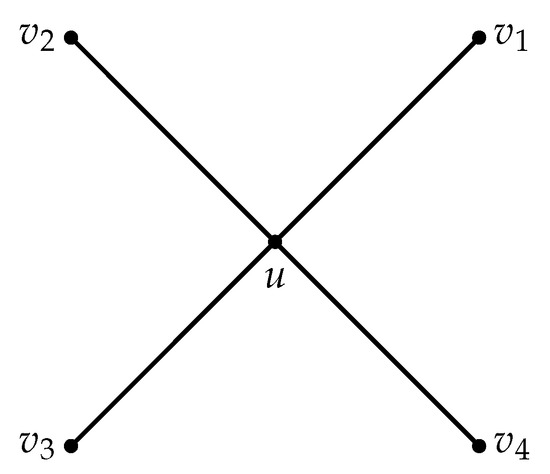
Figure 3.
contains no 3-face.
Let contain exactly one 3-face (see Figure 4). Note that and at most one of and is equal to 3 by Claim 9. If and , by (R3.3) since u is incident with at least two faces, each of which either is a good 4-face or a -face. If is equal to 3, by (R1.2) and (R3) since u is incident with at least two faces, each of which either is a good 4-face or a -face. By symmetry, when is equal to 3.
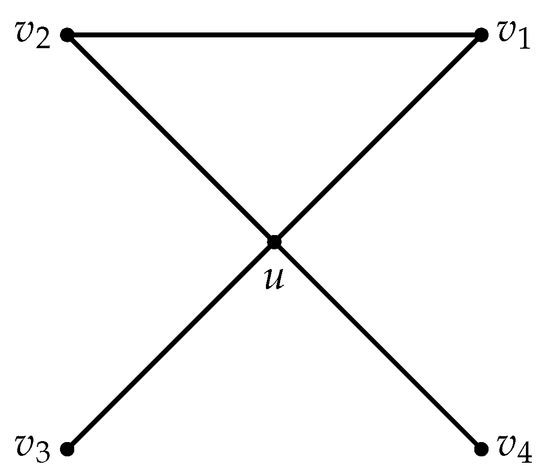
Figure 4.
contains one 3-face.
Let contain two 3-faces (see Figure 5). Note that by Claim 9 and of (b) in Figure 5 is not a 3-vertex by Lemma 1. If , by (R3.3) since u is incident with two faces, each of which either is a good 4-face or a -face. If , by (R1.2) and (R3.3), since u is incident with two faces, each of which either is a good 4-face or a -face. If , by (R1.2) and (R3.3) since u is incident with one face, which either is a good 4-face or a -face.

Figure 5.
contains two 3-faces; (a) two nonadjacent 3-faces; (b) two adjacent 3-faces.
Let contain three 3-faces (see Figure 6). Note that by Claim 9 and neither nor is a 3-vertex by Lemma 1 in Figure 6. If , at least one neighbor of u is a -vertex, and when one neighbor of u is 7-vertex, it is not adjacent to any real -vertex by Claim 13; so, by (R1) and (R3.3) since u is incident with one face, which either is a good 4-face or a -face. If and , u is adjacent to at least two -vertices; so, by (R1.3), (R1.4), and (R3.3) since u is incident with one face, which either is a good 4-face or a -face. If and , or . Since and are symmetrical in Figure 6, we can set . Then, , , and ; so, by (R1.2), (R3.2), and (R3.3) since u is incident with one face, which either is a good 4-face or a -face. If , , , , and by Claims 9 and 10. If , by (R3.2). If , then we may as well set since and are symmetrical in Figure 6. Thus, ; so, by (R1.2) and (R3.2). If , . Thus, and . So, by (R1.2) and (R3.2).
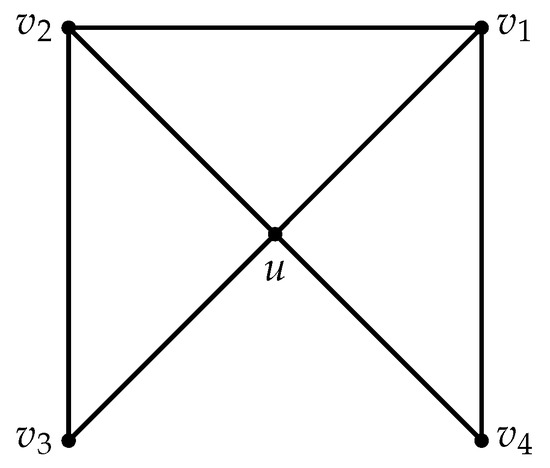
Figure 6.
contains three 3-faces.
Let contain four 3-faces (see Figure 7). Then, for by Lemma 1. Note that by Claim 9. If and , then u is adjacent to at least two 7-vertices by Claim 13. When u is adjacent to two 7-vertices, each of the two 7-vertices is not adjacent to any real -vertex by Claim 13, and so by (R3.1). When u is adjacent to at least three 7-vertices, by (R3.1). If and , we may as well set by symmetry. Then, at least one of , and is a 7-vertex by Claim 13. When one of , and is a 7-vertex, this 7-vertex is not adjacent to any real -vertex by Claim 13, and so by (R3.1) and (R3.2). When at least two of , and are 7-vertices, by (R3.1) and (R3.2). If and , by (R3.2). If and , u is adjacent to three -vertices by Claim 9; so, by (R1.3) and (R3.2). If and , u is adjacent to three -vertices by Claim 9; so, by (R1.4), (R3.1), and (R3.2).
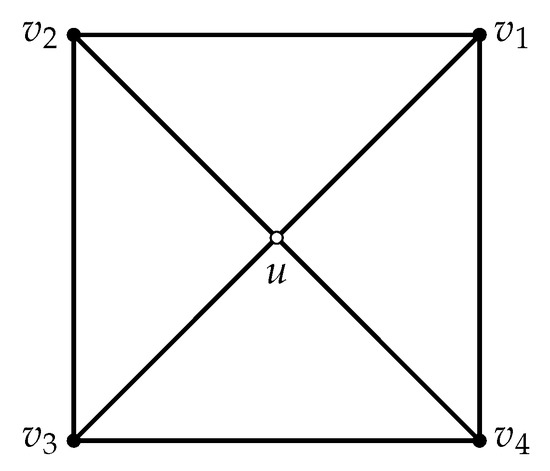
Figure 7.
contains four 3-faces.
Hence, the new charge of every false 4-vertex is non-negative.
By the above analysis, we obtain that the new charge of every member in is non-negative. This is a contradiction. The proof of Theorem 3 is completed.
4. Conclusions
In this paper, we proved that any IC-planar graph with satisfies the tnsd index conjecture by the discharging method and Combinatorial Nullstellensatz. Whether the bound can be improved is still open for future work. The difficulty in improving this bound is how to reduce the number of bad 3-neighbors of one vertex. Therefore, finding suitable technology to reduce the number of bad 3-neighbors of one vertex is our main future work in the study of the tnsd index of IC-planar graph.
Author Contributions
Methodology, D.Z.; software, F.C.; formal analysis, D.Z.; writing—original draft preparation, D.Z.; writing—review and editing, C.L. All authors have read and agreed to the published version of the manuscript.
Funding
This research was funded by Shangluo Science and Technology Plan Project (No. SK2017-40).
Institutional Review Board Statement
Not applicable.
Informed Consent Statement
Not applicable.
Data Availability Statement
Not applicable.
Acknowledgments
The authors are grateful to all anonymous reviewers and the editor for their inspiring and constructive comments and suggestions.
Conflicts of Interest
The authors declare no conflict of interest.
References
- Pilśniak, M.; Woźniak, M. On the total-neighbor-distinguishing index by sums. Graphs Comb. 2015, 31, 771–782. [Google Scholar] [CrossRef] [Green Version]
- Xu, C.; Ge, S.; Li, J. Neighbor sum distinguishing total chromatic number of 2-degenerate graphs. Discret. Appl. Math. 2018, 251, 349–352. [Google Scholar] [CrossRef]
- Li, H.; Liu, B.; Wang, G. Neighbor sum distinguishing total coloring of K4-minor-free graphs. Front. Math. China 2013, 8, 1351–1366. [Google Scholar] [CrossRef]
- Yang, D.; Sun, L.; Yu, X.; Wu, J.; Zhou, S. Neighbor sum distinguishing total chromatic number of planar graphs with maximum degree 10. Appl. Math. Comput. 2017, 314, 456–468. [Google Scholar] [CrossRef]
- Wang, J.; Ma, Q.; Han, X. Neighbor sum distinguishing total colorings of triangle free planar graphs. Acta Math. Sin. (Engl. Ser.) 2015, 2, 216–224. [Google Scholar] [CrossRef]
- Albertson, M.O. Chromatic number, independent ratio, and crossing number. Ars Math. Contemp. 2008, 1, 1–6. [Google Scholar] [CrossRef] [Green Version]
- Song, W.; Duan, Y.; Miao, L. Neighbor Sum Distinguishing Total Coloring of Triangle Free IC-planar Graphs. Acta Math. Sin. (Engl. Ser.) 2020, 36, 292–304. [Google Scholar] [CrossRef]
- Song, W.; Duan, Y.; Miao, L. Neighbor sum distinguishing total coloring of IC-planar graphs. Discret. Math. 2020, 343, 111918. [Google Scholar] [CrossRef]
- Song, C.; Xu, C. Neighbor sum distinguishing total colorings of IC-planar graphs with maximum degree 13. J. Comb. Optim. 2020, 39, 293–303. [Google Scholar] [CrossRef]
- Zhang, D. Neighbor Sum Distinguishing Total Choosability of IC-Planar Graphs without Theta Graphs Θ2,1,2. Mathematics 2021, 9, 708. [Google Scholar] [CrossRef]
- Alon, N. Combinatorial nullstellensatz. Combin. Probab. Comput. 1999, 8, 7–29. [Google Scholar] [CrossRef] [Green Version]
- Sun, L.; Yu, G.; Li, X. Neighbor sum distinguishing total choosability of 1-planar graphs with maximum degree at least 24. Discrete Math. 2021, 344, 112190. [Google Scholar] [CrossRef]
- Daniel, W.; Douglas, B. An introduction to the discharging method via graph coloring. Discrete Math. 2017, 340, 766–793. [Google Scholar]
Publisher’s Note: MDPI stays neutral with regard to jurisdictional claims in published maps and institutional affiliations. |
© 2021 by the authors. Licensee MDPI, Basel, Switzerland. This article is an open access article distributed under the terms and conditions of the Creative Commons Attribution (CC BY) license (https://creativecommons.org/licenses/by/4.0/).